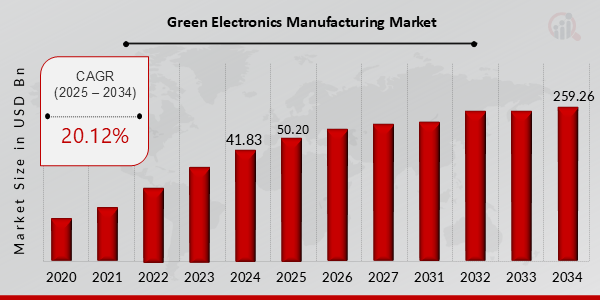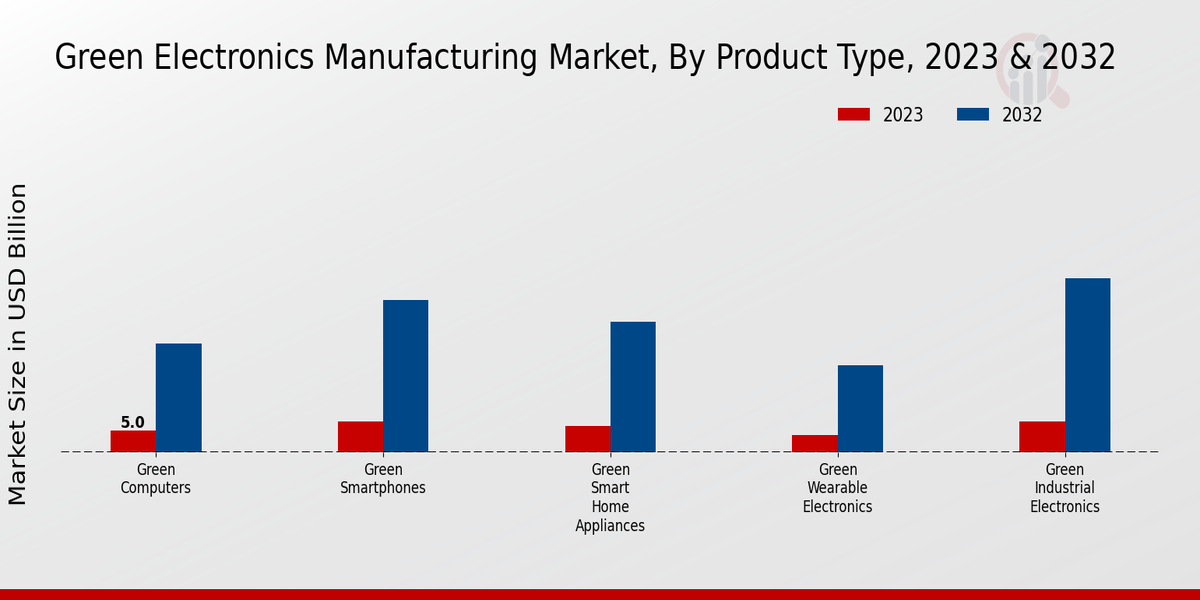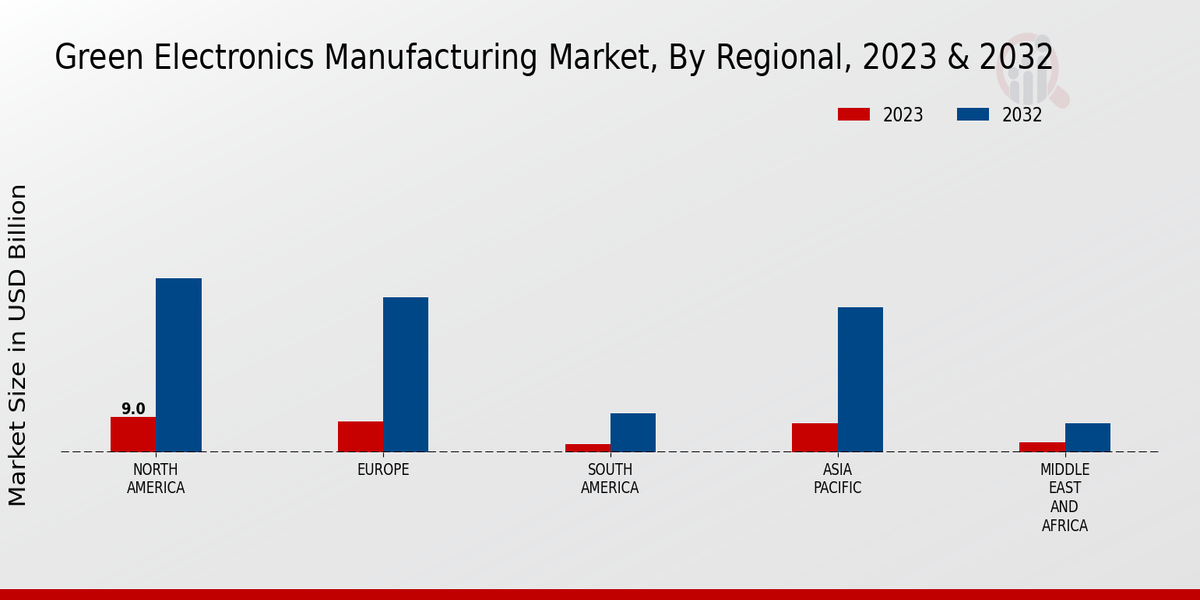Global Green Electronics Manufacturing Market Overview
Green Electronics Manufacturing Market Size was estimated at 41.83 (USD Billion) in 2024. The Green Electronics Manufacturing Market Industry is expected to grow from 50.20 (USD Billion) in 2025 to 259.26 (USD Billion) till 2034, exhibiting a compound annual growth rate (CAGR) of 20.12% during the forecast period (2025 - 2034).
Key Green Electronics Manufacturing Market Trends Highlighted
The Green Electronics Manufacturing Market is experiencing a surge in demand driven by heightened environmental consciousness and stringent regulations. Consumers and businesses are increasingly seeking eco-friendly products, promoting the adoption of sustainable manufacturing practices. Key drivers include the growing pressure to reduce carbon emissions and waste, as well as the desire to enhance brand reputation and customer loyalty.Opportunities lie in the development of innovative materials and technologies that minimize environmental impact. Partnerships between electronics manufacturers and suppliers of sustainable solutions are emerging to drive advancements.
Furthermore, the rise of IoT and Industry 4.0 is creating demand for energy-efficient and eco-friendly electronic devices, opening new avenues for market growth.Recent trends indicate a shift towards the use of recycled materials, renewable energy sources, and eco-friendly packaging. The integration of artificial intelligence (AI) into manufacturing processes is enabling data-driven decision-making and optimizing resource utilization. As the industry continues to evolve, the focus on green electronics manufacturing is expected to intensify, creating compelling opportunities for market participants.

Source: Primary Research, Secondary Research, MRFR Database and Analyst Review
Green Electronics Manufacturing Market Drivers
Rising Demand for Environmentally Sustainable Products
Both customers and enterprises are demonstrating an elevated level of concern toward the environmental impact of their purchases. In this context, many of them desire to get hold of goods manufactured in a way that does not harm the environment’s well-being to any sizable degree. As a result, “green” electronics manufacturing, which focuses on using eco-efficient materials, employing alternate energy sources, and not wasting either electricity or other kinds of energy, as well as not creating unrecyclable garbage, is quickly acquiring a wider following.Evidently, it will provide the impetus for the industry’s continued expansion in the near future.
Government Regulations and Incentives
In an attempt to reduce the environmental effects of the electronics industry and encourage green manufacturing practices, governments across the globe are enforcing regulations targeting the demand. These regulations focus on energy usage and hazardous materials and provide companies with incentives for adopting manufacturing technologies that are good for the environment. The situation is, therefore, conducive to the growth of the Green Electronics Manufacturing Market Industry.
Technological Advancements and Innovation
Ongoing advancements in technology are enabling the development of new and improved green electronics manufacturing techniques. These include the use of renewable energy sources, innovative materials, and advanced recycling processes. As technology continues to evolve, the Green Electronics Manufacturing Market Industry is expected to benefit from increased efficiency, reduced costs, and improved environmental performance.
Green Electronics Manufacturing Market Segment Insights:
Green Electronics Manufacturing Market Product Type Insights
The Green Electronics Manufacturing Market exhibits significant growth and diversification, particularly within its Product Type segment. In 2023, the market is valued at 29.04 USD Billion, with a projected escalation to 150.0 USD Billion by 2032. This impressive rise underscores the increasing global focus on sustainability as more consumers and businesses alike shift towards eco-friendly electronic products. Within this segment, Green Computers emerge as a pivotal player, with a valuation of 5.0 USD Billion in 2023 and climbing to 25.0 USD Billion in 2032, indicating a growing demand for energy-efficient computing solutions that reduce environmental impact.
Similarly, Green Smartphones demonstrate substantial growth, starting at 7.0 USD Billion in 2023 and expanding to 35.0 USD Billion by 2032, suggesting the importance of sustainability in mobile technology, where consumers are increasingly seeking devices that feature recyclable materials and energy-efficient performance.
Green Smart Home Appliances also play a notable role, valued at 6.0 USD Billion in 2023 and anticipated to rise to 30.0 USD Billion in 2032, as consumers embrace smart technology that maximizes energy efficiency and reduces waste in household settings.In the realm of wearable technology, Green Wearable Electronics has a current valuation of 4.0 USD Billion, projected to reach 20.0 USD Billion by 2032.
This segment reflects a surge in consumer interest in health-oriented gadgets that are produced sustainably while offering functionality and convenience. Lastly, Green Industrial Electronics holds a valuation of 7.04 USD Billion in 2023, with expectations to grow to 40.0 USD Billion by 2032, pointing to the significant investments in sustainable technology within industrial sectors to improve efficiency and minimize ecological footprints.The Green Electronics Manufacturing Market segmentation illustrates a robust and forward-thinking shift towards environmentally friendly electronics across various applications, driven by consumer preferences, technological advancements, and regulatory pressures for sustainability.

Source: Primary Research, Secondary Research, MRFR Database and Analyst Review
Green Electronics Manufacturing Market Material Type Insights
The Green Electronics Manufacturing Market is poised for substantial growth, with a valuation of 29.04 USD Billion in 2023. Within this market, the Material Type segment plays a crucial role, showcasing various materials that contribute to sustainability and eco-friendliness. Recycled/Reused Plastics have gained significant traction, reflecting a growing consumer awareness regarding environmental impact. Biodegradable Materials are also gaining momentum as businesses prioritize solutions that minimize waste, thus addressing hefty landfill concerns.Additionally, Low-Power Components are essential in reducing energy consumption, making devices more efficient and appealing to environmentally conscious consumers.
Energy-efficient displays, which provide superior performance while consuming less power, dominate market trends as leading manufacturers seek to enhance their product offerings. Lastly, the use of Lead-Free Solder is increasing as regulatory measures promote health and safety standards. The ongoing trends reflect a shift toward sustainable practices in the Green Electronics Manufacturing Market, driving growth and innovation amid environmental challenges.
Green Electronics Manufacturing Market Process Type Insights
In 2023, the Green Electronics Manufacturing Market is expected to be valued at 29.04 USD Billion, reflecting the growing emphasis on sustainable practices within the electronics industry. The Process Type segment is critical in driving this market forward, encompassing integral components such as Life Cycle Assessment (LCA), Design for Environment (DfE), and Waste Reduction Techniques.
Life Cycle Assessment plays a vital role by offering a comprehensive view of the environmental impacts associated with all stages of a product's life cycle, thus aiding manufacturers in making informed decisions.Design for Environment focuses on creating products that minimize ecological damage, promoting efficiency and sustainability while appealing to environmentally conscious consumers. Waste Reduction Techniques are essential as they help decrease the volume of waste generated during production processes, aligning with global sustainability goals.
Energy Conservation Measures are increasingly important as they contribute to lowering energy consumption in manufacturing, reflecting a shift towards more efficient operations. Lastly, Zero Waste Manufacturing addresses the growing concerns around landfill use by capturing and reusing waste materials, positioning this segment as a significant player in the market.The diverse nature of these processes underlines the importance of the Process Type sector in the Green Electronics Manufacturing Market revenue growth, shaping a sustainable future for the industry.
Green Electronics Manufacturing Market Certification Insights
The Certification segment of the Green Electronics Manufacturing Market plays a vital role in ensuring sustainable practices across the industry. In 2023, the market reached a valuation of 29.04 USD Billion, showcasing its growing significance in promoting eco-friendly manufacturing processes. Within this segment, various certifications such as Energy Star, EPEAT, and UL Environment help manufacturers meet stringent environmental standards. Energy Star certification is crucial for energy efficiency, while EPEAT focuses on electronics’ lifecycle impact, covering aspects from design to recycling.
The Green Electronics Council (GEC) drives innovation through educational initiatives, adding depth to the industry's commitment to sustainability. ISO 14001 enhances operational effectiveness by establishing robust environmental management systems. The market growth is fueled by rising consumer awareness, governmental regulations, and the increasing demand for sustainable products. However, challenges like compliance costs and varying international standards can affect implementation. Despite these challenges, opportunities exist for companies that leverage certifications for competitive advantage, thus contributing positively to the Green Electronics Manufacturing Market revenue by responding to the increasing need for corporate responsibility in today's market landscape.
Green Electronics Manufacturing Market End-Use Industry Insights
The Green Electronics Manufacturing Market is experiencing notable growth, valued at 29.04 USD Billion in 2023 and projected to reach significant heights by 2032. This market's segmentation by End-Use Industry reveals diverse applications, including Consumer Electronics, Healthcare, Automotive, Industrial, and Government sectors. Consumer Electronics plays a crucial role, driven by increasing demand for sustainable devices and energy-efficient solutions. The Healthcare segment benefits from advancements in eco-friendly medical equipment that enhance patient care while minimizing environmental impact.
The Automotive sector is significantly contributing due to the rise of electric vehicles, which necessitate sustainable manufacturing practices. Industrial applications are focused on integrating green technologies to optimize processes, reduce waste, and improve efficiency. Meanwhile, Government initiatives promoting sustainable manufacturing practices further strengthen the overall market. Each sector not only highlights unique requirements but collectively drives the overall growth of the Green Electronics Manufacturing Market, supported by the trend towards sustainability and innovation in manufacturing processes.
Green Electronics Manufacturing Market Regional Insights
The Green Electronics Manufacturing Market is experiencing substantial growth within its Regional segment, with market valuations set at 29.04 USD Billion in 2023 and projected to reach 150.0 USD Billion by 2032. North America stands out as a significant player, holding a valuation of 9.0 USD Billion in 2023 and expected to rise to 45.0 USD Billion by 2032, indicating its dominant position in sustainable manufacturing practices. Europe follows closely, valued at 8.0 USD Billion in 2023, showing strong potential for growth with a forecasted 40.0 USD Billion by 2032, driven by stringent environmental regulations.
The Asia Pacific region, valued at 7.5 USD Billion in 2023, is also noteworthy due to its expansive manufacturing capabilities, expected to grow to 37.5 USD Billion by 2032. South America, while smaller with a valuation of 2.0 USD Billion, demonstrates significant growth potential as it aims to enhance its green manufacturing initiatives, reaching 10.0 USD Billion by 2032.
Lastly, the Middle East and Africa, starting from a valuation of 2.54 USD Billion in 2023, represents an emerging market in green electronics, anticipated to increase to 7.5 USD Billion by 2032.Overall, these regional insights highlight the dynamic shifts and growth opportunities within the Green Electronics Manufacturing Market, shaped by regional demands and innovations.

Source: Primary Research, Secondary Research, MRFR Database and Analyst Review
Green Electronics Manufacturing Market Key Players And Competitive Insights:
Major players in the Green Electronics Manufacturing Market industry are constantly looking to innovate and improve their products, as well as expand geographically into new markets. This is leading to an increasingly competitive environment, with companies investing heavily in research and development to gain an edge over their competitors. Some of the Leading Green Electronics Manufacturing Market players are using strategic collaborations to share knowledge and resources, while others are focusing on mergers and acquisitions to consolidate market share.
Overall, the Green Electronics Manufacturing Market Competitive Landscape is expected to remain highly competitive over the next few years, with companies continuing to vie for market share through innovation, geographic expansion, and strategic partnerships.Dell Technologies has been active in the Green Electronics Manufacturing Market and has taken steps to reduce its environmental impact.
The company has set a goal of achieving net-zero greenhouse gas emissions by 2050 and has pledged to transition to 100% renewable energy by 2030. Dell Technologies is also working to reduce the use of hazardous materials in its products and is increasing the use of recycled materials.Samsung Electronics is another leading player in the Green Electronics Manufacturing Market and is also committed to reducing its environmental impact. The company has set a goal of becoming carbon neutral by 2050 and has pledged to invest $22 billion in sustainability initiatives over the next five years.
Samsung Electronics is also working to reduce the use of hazardous materials in its products and is increasing the use of recycled materials.
Key Companies in the Green Electronics Manufacturing Market Include:
- Hewlett Packard Enterprise
Green Electronics Manufacturing Market Industry Developments
The Green Electronics Manufacturing Market is projected to grow at a CAGR of 20.01% from 2023 to 2032, reaching a valuation of USD 150.0 billion by 2032. Growth in the market is attributed to increasing demand for sustainable electronics, coupled with government regulations and initiatives promoting the adoption of green manufacturing practices.
Asia-Pacific is expected to hold the largest market share, driven by rapid industrialization and rising environmental awareness in the region. Key industry participants include Samsung, LG Electronics, and Sony, who are investing in research and development to enhance their green electronics manufacturing capabilities. Recent developments include the launch of new green electronics recycling programs and the adoption of eco-friendly materials in the manufacturing process.
Green Electronics Manufacturing Market Segmentation Insights
-
Green Electronics Manufacturing Market Product Type Outlook
- Green Smart Home Appliances
- Green Wearable Electronics
- Green Industrial Electronics
-
Green Electronics Manufacturing Market Material Type Outlook
- Energy-Efficient Displays
-
Green Electronics Manufacturing Market Process Type Outlook
- Life Cycle Assessment (LCA)
- Design for Environment (DfE)
- Waste Reduction Techniques
- Energy Conservation Measures
-
Green Electronics Manufacturing Market Certification Outlook
- Green Electronics Council (GEC)
-
Green Electronics Manufacturing Market End-Use Industry Outlook
-
Green Electronics Manufacturing Market Regional Outlook
| Report Attribute/Metric |
Details |
|
Market Size 2024
|
USD 41.83 Billion
|
|
Market Size 2025
|
USD 50.20 Billion
|
|
Market Size 2034
|
USD 259.26 Billion
|
|
Compound Annual Growth Rate (CAGR)
|
20.12% (2025-2034)
|
| Report Coverage |
Revenue Forecast, Competitive Landscape, Growth Factors, and Trends |
|
Base Year
|
2024
|
|
Market Forecast Period
|
2025-2034
|
|
Historical Data
|
2020-2023
|
| Market Forecast Units |
USD Billion |
| Key Companies Profiled |
Apple, Samsung Electronics, Hitachi, IBM, Sony, Acer, Panasonic, NEC, Dell, Hewlett Packard Enterprise, Canon, Lenovo, Toshiba, ASUSTeK Computer, Fujitsu |
| Segments Covered |
Product Type, Material Type, Process Type, Certification, End-Use Industry, Regional |
| Key Market Opportunities |
Growing Demand for Sustainable ElectronicsGovernment Regulations and PoliciesTechnological AdvancementsRising Awareness of Environmental ImpactCost-effectiveness |
| Key Market Dynamics |
Rising demand for sustainable electronics Government regulations on environmental protection Technological advancements in green manufacturing |
| Countries Covered |
North America, Europe, APAC, South America, MEA |
Frequently Asked Questions (FAQ):
The Green Electronics Manufacturing Market is expected to be valued at 259.26 USD Billion by 2034.
The expected CAGR for the Green Electronics Manufacturing Market from 2025 to 2034 is 20.12%.
North America is projected to dominate the Green Electronics Manufacturing Market with an expected value of 45.0 USD Billion by 2032.
The market size for Green Smartphones is anticipated to reach 35.0 USD Billion by the year 2032.
The expected market size for Green Industrial Electronics by 2032 is projected to be 40.0 USD Billion.
Key players in the market include major companies such as Apple, Samsung Electronics, Hitachi, and IBM.
The anticipated market size of Green Computers is expected to be 25.0 USD Billion by 2032.
The market size for Green Smart Home Appliances is projected to be 30.0 USD Billion by the year 2032.
The market for Green Wearable Electronics is expected to grow to 20.0 USD Billion by 2032.
The expected market size for the Asia Pacific region by 2032 is projected to be 37.5 USD Billion.

















